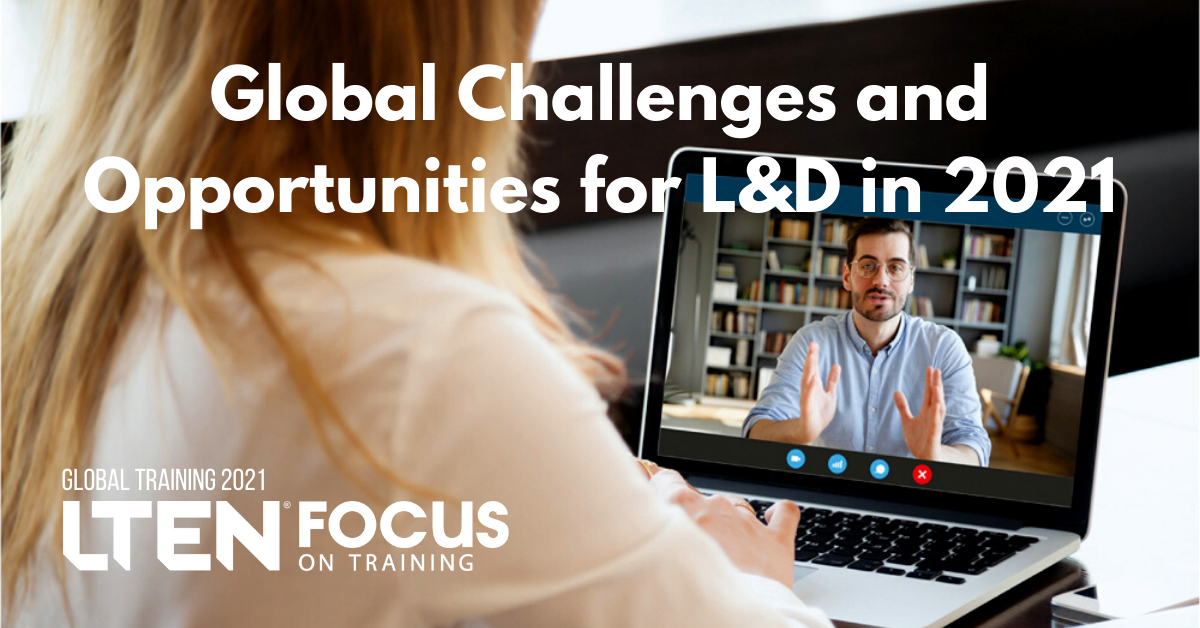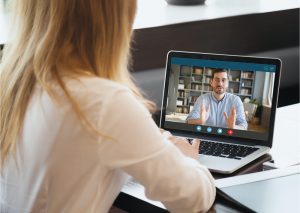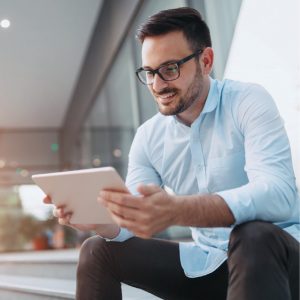
Global Challenges and Opportunities for L&D in 2021
Feature Story – By David Williams
A blend of virtual and face-to-face may emerge post-pandemic
 As we look ahead to a world beyond COVID-19, it is vital to consider how we will manage the shift from screen-based learning back to face-to-face learning. The opportunities for global collaboration, flexibility and cost-saving that virtual learning has offered us ensure that it will be retained as a working practice, but it would be a huge mistake to discard face-to-face experiences altogether.
As we look ahead to a world beyond COVID-19, it is vital to consider how we will manage the shift from screen-based learning back to face-to-face learning. The opportunities for global collaboration, flexibility and cost-saving that virtual learning has offered us ensure that it will be retained as a working practice, but it would be a huge mistake to discard face-to-face experiences altogether.
High quality learning and development (L&D) isn’t about transmitting content or knowledge to learners through screens or devices, it’s about provoking them to want to learn and change. This is harder to achieve through virtual experiences alone.
The way forward will be through blending the two: Combining powerful, emotionally charged face-to-face experiences that provoke, challenge and encourage people to step out of their comfort zones with high quality virtual learning, thereby allowing you to personalize and extend the scope of each learning journey through both electives and core modules of tailored content. When positioned with a well-designed experiential learning platform, valuable management feedback and evaluative data also become part of the mix.
Employee Well-Being
One positive consequence of the pandemic has been the way that well-being has risen up the agenda. People have higher expectations now for their well-being and are getting much better at prioritizing their mental health. L&D professionals need to think about the mental health consequences of how they invite people to participate in their experiences. Fostering a psychologically safe space in which people feel confident enough to bring their whole selves is key.
Creating better environments for mental health will also involve prioritizing time spent outdoors. There is an abundance of evidence that makes clear the link between mental health and time spent in the natural world, and the lockdowns and restrictions of the past year demonstrate this, with many more people now spending time outside whenever they physically can. This doesn’t have to involve any extreme activity — when it comes to mental health and well-being, going for a walk and a talk is just as effective as climbing a mountain! Furthermore, L&D experiences can be made much more impactful if participants are encouraged to venture outside while they reflect upon their learning.
Trusting Choice
Another consequence of the past year is that employers and L&D specialists will have to revise and update their attitudes to trust. Many employees have been trusted to work from home alone for a long time now, so there will be a heightened expectation for their employers to trust them to make their own decisions about where they work, how they work and when they work – and the same goes for learning too.
 We have long talked about the differences in individuals’ learning styles, but the need to take them into account has become much more important now. L&D organizations need to prioritize creating their learning journeys around different preferences and learning styles, building flexibility into their designs. There will always be some set pieces at the core of any learning journey, but surrounding that there needs to be more freedom for people to be able to learn in the way they want to learn.
We have long talked about the differences in individuals’ learning styles, but the need to take them into account has become much more important now. L&D organizations need to prioritize creating their learning journeys around different preferences and learning styles, building flexibility into their designs. There will always be some set pieces at the core of any learning journey, but surrounding that there needs to be more freedom for people to be able to learn in the way they want to learn.
Giving participants more flexibility empowers them to make the most of their learning journey.
Leading Organizational Change
Looking ahead, one thing we can be sure of is that no organization will be the same as it was before the pandemic.
Right now, the more entrepreneurial organizations will be reflecting upon the shape of their business and considering how best to move forward. They will be asking themselves what type of organization they want to be in the future, which services or product lines they want to offer, and how can they be more flexible and better prepared for the next crisis – whenever that may be.
Now is the time to ask these big questions, and the most forward-thinking organizations will be putting them straight to their people. Because when it comes to change, it is not all about agility, it is also about adopting a collaborative approach in which change is something that everyone participates in.
The lessons of the past year teach us that no one person has all the answers, and that the best leaders are those who have the confidence to ask questions instead, holding space open for others to step into. Working together on scenario planning, exploring “what ifs” and maintaining flexibility makes change and transformation much more impactful. This mode of dispersed leadership also helps to liberate the potential of your people, transforming them into agents of change rather than passive followers. Facilitating this process is now a key L&D requirement.
Merging Personal, Brand and Organizational Values
The process of creating brand values for marketing purposes is similar to the process we use to identify people values in human resources. But what happens if your brand and people values are not aligned? In 2021, L&D and marketing need to work far more closely together to avoid the tension that this potential clash could create.
Agile and responsive organizations will have closely aligned brand, organizational and people values that are practiced daily. Questions surrounding strategy and services cannot be considered in isolation from discussions about people and retention. For example, instead of a training course on leadership being separate from a training course on products, both will become blended and interdependent.
Another example is that meetings will bring issues and tasks together along with clear processes from HR that structure how the meeting unfolds and what everyone can expect from it. Work-based projects and innovation exercises are prioritized as action learning experiences. Learning in the flow of work becomes the norm.
Retention in a Post-COVID World
Having an organization with strong, integrated people and brand values is going to be vital going forward. In the wake of the pandemic, people will have different priorities and are going to be more focused than ever on making the best use of their time. Primarily, this includes working for an organization that reflects their own values and ambitions and that provides them with real opportunities to flourish and succeed.
The doors of opportunity have been shut for a long time now, with many employees unable to move on or try anything new. As soon as those doors open, many people are likely to start looking around at what else is out there. Indeed, there could be a lot of moving and change.
One way to ensure your organization against this is to prioritize employee engagement now. Offering dynamic learning experiences and accelerating personal development will demonstrate to your people that they really are valued. To compete for talent in a world of opportunity means demonstrating that yours really is an organization worth working for.
The challenges facing L&D in the coming year are also tremendous opportunities – for growth, for learning and for change. Are you ready?
David Williams is CEO and founder of Impact International. Email David at
david.williams@impactinternational.com.








